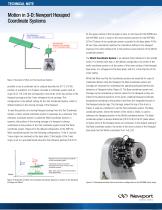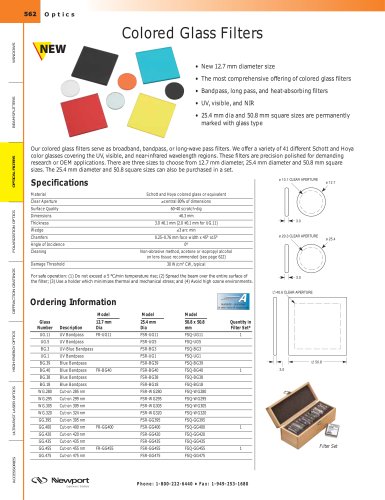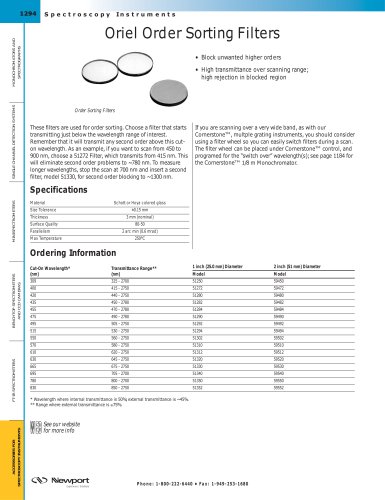Catalog excerpts

TECHNICAL NOTE Motion in 3-D: Newport Hexapod Coordinate Systems Controlling Motion in 3-D space requires a user to have a clear understanding of the relationship between end effector positions and positions of devices under test. Regardless of whether it is an industrial positioning platform used in machinery, using a cutting tool and a work piece, or an electro-optical beam steering setup for advanced research in a diffractometry using a laser beam and a sample, precise readings and controls of both end effectors and devices are of key importance. Due to the complexity of motion in 3-D, multi-axis systems can present many issues without careful design and considerations. Newport Hexapods provide innovative user-definable coordinate systems to answer this challenge, leading the way of user-friendly multi-axis positioning platforms available on the market. This tech note illustrates the three user-definable coordinate systems and helps with integration and configuration of the Hexapods in experimental setups or manufacturing process, thus to help maximize the benefits of using the line of Newport’s Hexapod products. To uniquely represent the position of a moving platform in three-dimensional space, one must specify its spatial location and angular orientation with three linear and three rotational coordinate values. The Newport HXP series of Hexapods uses a Cartesian coordinate system for translation and the Bryant angles for rotation, which are frequently used in robotics and aviation. (See Figure 1) A position (X Y Z U V W) represents a XYZ location of the center point of the platform in a 3-D space in right-handed Cartesian coordinate system as well as orientation in roll, pitch and yaw (U V W, TaitBryan angles definition). Figure 1: Setup Configuration for Optical Quality Testing with Gimbal To understand how the position (X Y Z U V W) is reached in the Hexapod coordinate systems, consider a move defined by position (X Y Z U V W) starting from the position (0 0 0 0 0 0). The Tool coordinate system is set to the position (X Y Z) in the Work coordinate system. Then, it rotates about the z axis of the Tool coordinate system (W), rotates about the new y axis of the Tool coordinate system (V) and rotates about the new x axis of the Tool coordinate system (U). All rotations are made clockwise for positive rotations. When positioning commands are given in Cartesian coordinates and Bryant angles, they are transformed by the Newport HXP controller to the specific positions and velocities for each of the six Hexapod actuators before execution. All individual positions for the six actuators are taken as a set to define a unique position (location and orientation) of the Hexapod in the coordinate system. The transformation of coordinate to the actuator lengths is fully transparent. Understanding the Tool, Work and Base coordinate systems How does the Hexapod uniquely determine the position (location and orientation in X Y Z U V W)? As we are familiar with scalar fields in mathematics, a point is a sufficient geometric element to specify spatial positions (X Y Z) in a 3-D space. However, this representation is insufficient to identify directions associated with angular positions (U V W). It is however
Open the catalog to page 1
TECHNICAL NOTE Motion in 3-D: Newport Hexapod Coordinate Systems 0), the upper surface of the top plate is close to mid travel for the HXP50 and the HXP1000, and it is close to the lower extreme position for the HXP100); 3) The XY plane of the coordinate system is parallel to the base plate; 4) The W-axis (Yaw orientation) matches the orientation defined in the Hexapod drawing. (The motor cables point in the positive X-axis direction of the World coordinate system.) The World Coordinate System is an absolute fixed reference to the outside world. It is defined such that, in the default...
Open the catalog to page 2
TECHNICAL NOTE Motion in 3-D: Newport Hexapod Coordinate Systems Why is the Base coordinate system defined relative to the World coordinate system, instead of the Work coordinate system? By referencing the World coordinate system, it is possible to take into account any change in the position of the Hexapod without affecting the motion commands of the Tool in the Work coordinate system. A good example is a Hexapod mounted on a moving platform at the center of a multi-axis goniometer in a diffractometry application. (Figure 4) When the Hexapod itself is rotated or moved to a different...
Open the catalog to page 3
Motion in 3-D: Newport Hexapod Coordinate Systems axes relative to the beam from the starting position, allowing the material processing on the surface of the sample, as an example. This two pivot concept also applies to the inspection, metrology or traditional machining processes. Typical applications for the Hexapod include optical alignment and calibration, biomedical engineering and surgical robotics, satellite and telescope positioning, sensor metrology and calibration, and semiconductor test and metrology. For additional information, please visit the Newport HXP series Hexapod webpage...
Open the catalog to page 4All MICRO-CONTROLE / Spectra-Physics catalogs and technical brochures
-
Precision Motion Control
27 Pages
-
OPTICAL FIBER ALIGNMENT
6 Pages
-
SA2_90028936F
1 Pages
-
10BPF10-370_ROHS
1 Pages
-
10BPF10-320_ROHS
1 Pages
-
10BPF10-310
1 Pages
-
M-401
1 Pages
-
Tunable Diode Lasers
16 Pages
-
Custom Component Solutions
6 Pages
-
Vision IsoStation Brochure
5 Pages
-
Nanopositioning Solutions
55 Pages
-
newport ressource
1640 Pages
-
Motion PL30
24 Pages
-
CONEX-AG-LS25-27P
2 Pages
-
Nanopositioners
40 Pages
-
Prisms and retroreflectors
9 Pages
-
Beamsplitters
34 Pages
-
Spherical and aspherical lenses
35 Pages
-
Optrical mirror
33 Pages
-
Systems Solutions brochure
6 Pages
-
Fast Steering Mirrors
4 Pages
-
Optical Delay Line Kit
1 Pages
-
Long Scan Autocorrelator
1 Pages
-
I-V Test Station
2 Pages
-
Projects in Optics
2 Pages
-
Projects in Interferometry
2 Pages
-
Azimuth / Elevation Gimbals
2 Pages
-
Air-Bearing System
2 Pages
-
X-Ray Diffractometer
2 Pages
-
Motion System
2 Pages
-
Pick & Place Machine
2 Pages
-
Metrology Positioning System
2 Pages
-
I-500 Series Pneumatic Isolators
1 Pages
-
LabLegs™ Upgrade Kits
1 Pages
-
UCS Series Cleanroom Tables
1 Pages
-
TE Series Table Enclosures
1 Pages
-
LTE Series Light Tight Enclosure
1 Pages
-
Oriel Integrating Spheres
5 Pages
-
Oriel Inspection Probes
1 Pages
-
Oriel Flanged Sample Compartment
1 Pages
-
Oriel Focusing Lens Assembly
2 Pages
-
Xenon Flashlamps
2 Pages
-
Oriel InstaSpec X CCD
3 Pages
-
Oriel Mini Monochromator
3 Pages
-
Oriel 77200 1/4 m Monochromator
3 Pages
-
OSM2 Series Spectrometers
2 Pages
-
Oriel Optical Choppers
2 Pages
-
Electronic Safety Shutters
1 Pages
-
Oriel Optical Shutter
1 Pages
-
Iris Diaphragms
1 Pages
-
Beam Apertures for Light Sources
1 Pages
-
Adaptor Washers, Screw Sets
1 Pages
-
Mounting Bridles
1 Pages
-
Adaptors and Retaining Rings
1 Pages
-
Opto-Mechanical Components Set 2
1 Pages
-
Opto-Mechanical Components Set 1
1 Pages
-
X26 Series Mirror Mount
1 Pages
-
Mini Optical Rails and Carriers
2 Pages
-
Slotted Bases
2 Pages
-
SDS Series Angle Brackets
1 Pages
-
Rotation Adaptor
1 Pages
-
PBN Series Base Plates
1 Pages
-
Mounting Plates and Platforms
1 Pages
-
Modular Riser Plates
1 Pages
-
Magnetic Bases
2 Pages
-
Kinematic Stops and Nudgers
1 Pages
-
Kinematic Bases
2 Pages
-
Fixed Height Platforms
1 Pages
-
EQ Series Angle Brackets
2 Pages
-
Base Clamps
1 Pages
-
360 Series Angle Brackets
1 Pages
-
VALUMAX® Posts and Post Holders
1 Pages
-
Rod Platforms
1 Pages
-
Rod Clamps
1 Pages
-
Posts and Post Holders
3 Pages
-
Post Clamps and Accessories
1 Pages
-
Pedestal-Base Post Holders
2 Pages
-
Modular Construction System
1 Pages
-
Holders for Pedestal Posts
1 Pages
-
Heavy Duty Rod Systems
2 Pages
-
Dual Rod Systems
1 Pages
-
Breadboard Support Posts
1 Pages
-
Pedestal Post System
2 Pages
-
VersaStar™ Modular Filter Wheel
1 Pages
-
Motorized Filter Wheels
1 Pages
-
Manual Filter Wheels
1 Pages
-
Indexed Filter Wheel Mounts
1 Pages
-
Filter Holders
1 Pages
-
Filter and Optic Holders
1 Pages
-
V-Blocks
1 Pages
-
Precision Beam Steerers
1 Pages
-
Polarizer Rotation Mounts
1 Pages
-
Pockels Cell Positioner
1 Pages
-
Kin-a-Flip Mount
1 Pages
-
Diffraction Grating Mount
2 Pages
-
Cube Beamsplitter Holders
1 Pages
-
Beam Steerers
1 Pages
-
Aegis Qube™ Beam Routing System
5 Pages
-
Variable Lens Holder
1 Pages
-
Self-Centering Lens Mounts
1 Pages
-
Precision XY Optic Positioners
1 Pages
-
Multi-Axis Lens Positioners
4 Pages
-
Lens Focusing Mount
1 Pages
-
Fixed Lens Mounts
1 Pages
-
Cylindrical Lens Holders
1 Pages
-
Compact Lens Positioners
1 Pages
-
Adjustable Lens Mounts
1 Pages
-
UV Objective Lenses
1 Pages
-
Reflective Microscope Objectives
2 Pages
-
Precision Objective Lenses
1 Pages
-
Objective Lenses
1 Pages
-
Laser Diode Objective Lenses
1 Pages
-
Ultrafast Laser Chirped Mirrors
2 Pages
-
Ultrafast Laser Beam Sampler
1 Pages
-
Broadband Hollow Retroreflectors
1 Pages
-
Volume Bragg Gratings™
1 Pages
-
Plane Ruled Reflection Gratings
2 Pages
-
Pellicle Beamsplitters
1 Pages
-
Broadband Beam Samplers
1 Pages
-
Zero-Order Quartz Wave Plates
1 Pages
-
Zero-Order Precision Wave Plates
1 Pages
-
Precision Linear Polarizers
1 Pages
-
Polarcor™ Linear Polarizers
1 Pages
-
Glan-Laser Calcite Polarizers
1 Pages
-
Glan-Thompson Calcite Polarizers
1 Pages
-
Broadband Polarization Rotators
1 Pages
-
Infrared Lenses
1 Pages
-
BK 7 Precision Bi-Convex Lenses
2 Pages
-
BK 7 Precision Bi-Concave Lenses
1 Pages
-
Molded Glass Aspheric Lenses
3 Pages
-
Aspheric Condenser Lenses
1 Pages
-
Spherical Ball Micro Lenses
1 Pages
-
Precision Cylindrical Lens Sets
1 Pages
-
Gradient Index Micro Lenses
2 Pages
-
Three-Axis Spatial Filters
2 Pages
-
Precision Singlet Lens Sets
3 Pages
-
OptiSet™ Optics Sets
2 Pages
-
Laser Collimator
1 Pages
-
Laser Beam Expanders
2 Pages
-
High-Energy Pinhole Apertures
1 Pages
-
High-Energy Variable Attenuators
3 Pages
-
High-Energy Laser Beam Expanders
2 Pages
-
Electronic Shutter System
1 Pages
-
Compensated Attenuators
1 Pages
-
UV Beam Viewer
1 Pages
-
Shear Plate Collimation Tester
1 Pages
-
Sapphire Windows
1 Pages
-
Interferometer Flats
1 Pages
-
High-Energy Laser Wedged Windows
1 Pages
-
Parallel Windows
1 Pages
-
Light Pipe Homogenizer
1 Pages
-
VALUMAX® Right-Angle Prisms
1 Pages
-
Precision Right-Angle Prisms
1 Pages
-
VALUMAX® Broadband Mirrors
2 Pages
-
Ultra-Low Loss SuperMirrors™
2 Pages
-
Laser Line Dielectric Mirrors
2 Pages
-
High-Energy Nd:YAG Laser Mirrors
2 Pages
-
Broadband SuperMirrors™
1 Pages
-
Broadband Metallic Mirrors
2 Pages
-
Broadband Dielectric Mirrors
2 Pages
-
Oriel TE Cooler Controller
1 Pages
-
Oriel Laboratory Power Supply
1 Pages
-
Oriel Current Preamplifier
1 Pages
-
Micro-Beam Profiler
1 Pages
-
Laser Beam Profiler
2 Pages
-
High-Speed Photodetectors, GHz
7 Pages
-
Oriel Silicon Detectors
2 Pages
-
Oriel Pb and PbSe Detectors
2 Pages
-
Oriel InGaAs and Ge Detectors
2 Pages
-
Oriel Photomultiplier Tubes
2 Pages
-
Fiber Optic Detectors
2 Pages
-
PulseScout Autocorrelator
2 Pages
-
Heat Control Filters
1 Pages
-
Colored Glass Filters
3 Pages
-
Bandpass Filters
4 Pages
-
Laser Line Filters
2 Pages
-
Infrared Neutral Density Filters
1 Pages
-
Short and Long-Wave Pass Filters
2 Pages
-
Oriel Order Sorting Filters
1 Pages
-
UZ Series Vertical Linear Stages
2 Pages
-
HXP100 Hexapod
2 Pages
-
BG Series Goniometric Cradles
4 Pages
-
EL/EN Series Lab Jacks
1 Pages
-
ECN/ECR Series Lab Jacks
2 Pages
-
Single-Mode Fiber Couplers
1 Pages
-
Multimode Fiber Couplers
2 Pages
-
GRIN Lens Fiber Couplers
1 Pages
-
Fiber Optic Positioners
3 Pages
-
466A Series XYZ Flexure Stages
1 Pages
-
BM Series Micrometers
2 Pages
-
Apex Fiber Illuminators
2 Pages
-
Series Q Deuterium Sources
1 Pages
-
Deuterium Lamp Power Supplies
1 Pages
-
Deuterium Lamps
2 Pages
-
Apex Deuterium Lamp Sources
1 Pages
-
Spacer Tubes for Light Sources
1 Pages
-
Oriel Ozone Eater
1 Pages
-
Ozone Blowers
1 Pages
-
Flange Mounted Cells
1 Pages
-
Beam Turning Assemblies
2 Pages
-
Aspherab Lens Assemblies
2 Pages
-
Mounts for Beam Probes
1 Pages
-
Liquid Filters for Light Sources
1 Pages
-
Input Hood for Light Sources
1 Pages
-
Holders for Oriel Single Fibers
2 Pages
-
Flanged Mounts for Fiber Bundles
1 Pages
-
Filter Holder for Beam Probes
1 Pages
-
Coupling Rings for Light Sources
1 Pages
-
Flood Exposure Sources
6 Pages
-
Mask Alignment Tools
4 Pages
-
Reference Solar Cell and Meter
1 Pages
-
Class A Solar Simulators
3 Pages
-
150 - 300 W Solar Simulators
2 Pages
-
150 W Low Cost Solar Simulator
2 Pages
-
Apex Monochromator Illuminators
4 Pages
-
Quartz Tungsten Halogen Lamps
3 Pages
-
Blackbodies
2 Pages
-
Apex Infrared Light Sources
2 Pages
-
Xenon Flashlamp Systems
2 Pages
-
Uniform Illuminators
3 Pages
-
Simplicity Series Arc Sources
2 Pages
-
Series Q Lamp Housings
4 Pages
-
Series Q Arc Lamp Sources
2 Pages
-
Silicon Carbide Light Source
1 Pages
-
Oriel PhotoMax Lamp Housing
3 Pages
-
Fading Test System
1 Pages
-
Digital Arc Lamp Power Supplies
2 Pages
-
Modular Infrared Light Sources
2 Pages
-
DC Short Arc Lamps
3 Pages
-
1600 W Research Arc Lamp Sources
1 Pages
-
Research Arc Lamp Housings
3 Pages
-
Apex Arc Lamp Sources
2 Pages
-
Calibrated Sources and Services
2 Pages
-
Pencil Style Calibration Lamps
3 Pages
-
Laser Diode Adaptors
1 Pages
-
Cylindrical Laser Mounts
1 Pages
-
Laser Diode Drivers, 500B Series
2 Pages
-
TEC Controller, 300B Series
2 Pages
-
VBG Raman Laser Modules
2 Pages
-
Laser Diode Modules, LQN Series
2 Pages
-
Alignment Laser
1 Pages
-
Ultraviolet Safety Equipment
1 Pages
-
Laser Safety Glasses and Goggles
4 Pages
-
Laser Safety Windows
1 Pages
-
Infrared IR Viewer
1 Pages
-
177 Air-Cooled Ion Lasers
2 Pages
-
Beam Dump
1 Pages
-
Empower ® Q-Switched Laser
2 Pages
-
V-Xtreme™ Q-Switched Laser
2 Pages
-
Fiber Pigtailed Laser Diode
1 Pages
-
488 nm CW Laser- Cyan™ OEM
2 Pages
-
CW Lasers- Excelsior® OEM
4 Pages
-
Inspire™ OPO Family
2 Pages
-
Polarization Controller, Manual
2 Pages
-
Fiber Optic In-Line Polarizers
1 Pages
-
Fiber Optic Depolarizers
1 Pages
-
Mode Scrambler
1 Pages
-
Index-Matching Fluid
1 Pages
-
Fiber Optic Scribes
1 Pages
-
Fiber Jacket Stripper
1 Pages
-
Variable Ratio Couplers
2 Pages
-
Fixed Fiber Optic Attenuator
1 Pages
-
Fiber Optic Switches
2 Pages
-
Kevlar® Shears
1 Pages
-
Fiber Preparation Kit
1 Pages
-
Fiber Optic Splice
1 Pages
-
Benchtop Couplers and WDMs
1 Pages
-
Fiber Coating Stripper
1 Pages
-
Electronic Fiber Cleavers
1 Pages
-
Fiber Optic Isolator
2 Pages
-
Fiber Pigtailed Collimator
1 Pages
-
Fiber Optic Collimators
2 Pages
-
Photonic Crystal Fibers
4 Pages
-
Oriel Multi-track Fiber Bundles
2 Pages
-
Communication Grade Fibers
1 Pages
-
Infrared Fibers
1 Pages
-
Single Branch Fiber Bundles
1 Pages
-
Multi-Branch Fiber Optic Bundles
1 Pages
-
Power Delivery Fibers
1 Pages
-
Liquid Light Guides
2 Pages

































































































































































































































































































































































































































































































































































































































































